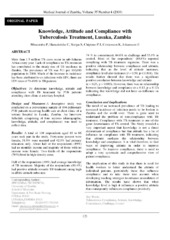| dc.description.abstract | More than 1.5 million TB cases occur in sub-Saharan Africa every year. Lack of compliance to TB treatment has contributed to the steady rise of TB incidence in Zambia. The prevalence of TB was 511 per 100,000 population in 2000. Much of the increase in incidence has been attributed to co-infection with HIV, there are HIV rates of 70-80% in TB patients Objectives: To determine knowledge, attitude and compliance with TB treatment by PTB patients attending chest clinic at a tertiary hospital. Design and Measures:A descriptive study was conducted on a convenience sample of 104 pulmonary PTB patients receiving health care at chest clinic of a tertiary hospital in Lusaka, Zambia. An Interview Schedule comprising of four sections (demographic, knowledge, attitude, and compliance) was used to collect data. Results: A total of 104 respondents aged 18 to 66 years took part in the study. Forty-nine percent were female, 51.9% were married and 42.3% had primary education only. About half of the respondents (49%) had no monthly income and majority of those with no income were female. Two thirds of the respondents (76%) lived in high-density areas. Half of the respondents (49%) had average knowledge of TB treatment. Majority of the respondents (89.4%) had positive attitude towards TB treatment rating high in all the attitude subscales 74 % in commitment, 84.6% in challenge and 55.8% in control. Most of the respondents’ (80.8%) reported complying with TB treatment regimens. There was a positive relationship between compliance and attitude, indicating that as the level of attitude increases, compliance level also increases (r = 0.59, p < 0.001). The results further showed that there was a significant positive correlation between knowledge and attitude (r = 0.25, p = 0.005). However, there was no relationship between knowledge and compliance (r = 0.12, p = 0.12) indicating that knowledge did not have an influence on compliance. Conclusion and Implications The trend of an increased prevalence of TB leading to increased incidence of infection needs to be broken in Zambia and the world over. There is great need to understand the problem of non-compliance with TB treatment. Compliance with TB treatment is one of the great determinants of TB control. The Study revealed a very important aspect that knowledge is not a direct determinant of compliance but that attitude has a lot of influence on compliance with TB treatment, indicating that attitude mediates the relationship between knowledge and compliance. It is vital therefore, to find ways of improving attitude in order to improve compliance. To improve compliance, there is need to adopt a very systematic and comprehensive view of patient compliance. The implication of this study is that there is need for health workers to better understand the attitude of individual patients, particularly those that influence compliance and to take these into account when developing teaching strategies to enhance assimilation of information. The results have shown that when knowledge level is high it influences a positive attitude that consequently influences compliance positively. | en_US |
